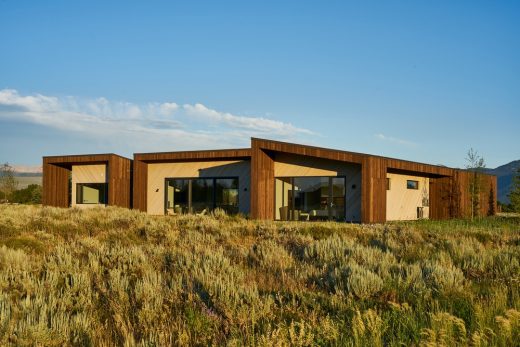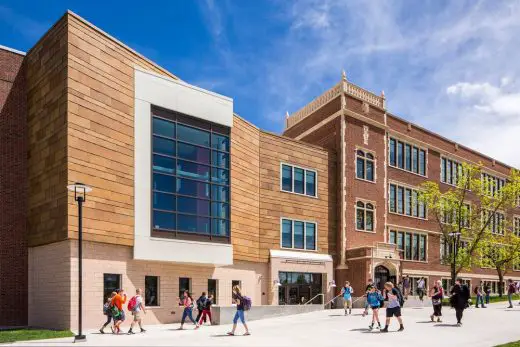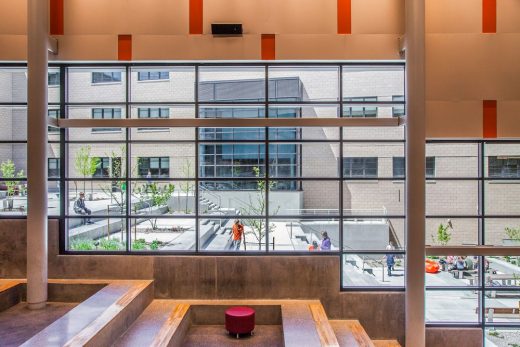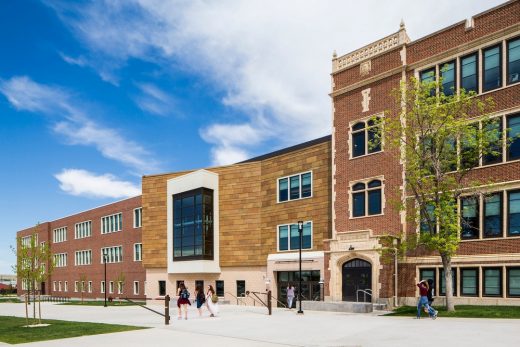Natrona County High School in Casper Wyoming building, US Campus design, American architecture images, WY education facility
Natrona County High School in Casper, Wyoming
Learning Facility Project USA design by Bassetti Architects
Apr 29, 2019
Design: Bassetti Architects
Location: Casper, Wyoming, USA
Photos by Jeff Amram and Fred Fuhrmeister
Natrona County High School
Originally designed to house both Casper College and Natrona County High School, the Collegiate Gothic-inspired complex was constructed between 1924 and 1927 and is listed on the National Register of Historic Places.
New work included the complete renovation of the existing 145,000-square-foot historic complex, and a 137,000-square-foot addition. To ensure continued occupancy throughout construction, construction was divided into six phases, spanning almost five years.
The design takes its inspiration from the district’s guiding principles: a culture of empowerment, inventive learning settings, collaborative learning environments, a memorable campus, and meaningful community partnerships. The revitalized school, both historic and new, is organized around four career academies focusing on a wide variety of teaching and learning pathways including direct institutional, project-based learning, collaboration, and presentation.
“The restoration of NCHS was shaped by three overarching ideas: a shift in the educational approach focused on career-based learning opportunities; upgrades to the historic campus targeting preservation, resilience, and vitality; safe continuous occupancy for students and staff.” – Lorne McConachie, Principal at Bassetti Architects.
Visible learning throughout the building sparks student engagement. Displays, both analog and digital, trigger student interest. Open presentations prompt involvement. Visible collaboration models critical skills for future success. Staff presence propels good behavior.
Student interests pique involvement and student excitement ignites school pride. The reorganization of the school into academies encourages and supports lifelong learning by offering a wide variety of pathways within the various disciplines. Hands-on learners now have readily available shops and studios to pursue their preferred learning approach.
Traditional learning modalities are supported with numerous flexible classrooms, able to support direct instruction or Socratic dialog. Project-based learning is accessible in highly transparent flex labs and science labs spread throughout the school.
Collaboration is enhanced by the integrated academy layout and dispersed teacher planning areas. Formal and informal presentation spaces include the large theatre, black box, and tiered commons.
Numerous active and passive strategies reduced energy and increased occupant comfort, including the installation of active chilled beams, condensing boilers, and heat recovery units. The design provides access to natural daylight and views to 98% of classroom and staff spaces. The remodel upgraded the envelope of the existing walls by adding continuous insulation behind the masonry, improving both thermal performance and air infiltration rates.
Walls and roofs in the new addition were insulated beyond code minimums to provide a robust energy-saving envelope. Windows throughout the new and remodeled portions were upgraded with a high-performance, double low-e coating that achieves a u-value comparable to triple-pane units. The building uses a highly efficient Active Chilled Beam system for heating and cooling in classroom spaces.
The revitalized 22.5-acre school campus is organized around the four career academies with shared facilities (historic theatre, student commons, library, and physical education) that are aligned through the center of the building. The restoration preserved the historic facades of the landmark structure to the south and created a major, contextually responsive addition to the north.
The entire building was organized around a protected inner courtyard with new secure entries located at the gaskets between historic and new construction. The renovation and additions have transformed the landmark school into a vibrant 21st century learning environment serving the academic, physical, and social well-being of students and staff, while simultaneously enhancing the building’s presence within the community.
Natrona County High School, Wyoming – Building Information
Architects: Bassetti Architects
Project consultant team:
Architecture and Interior Design: Bassetti Architects
Civil Engineer: WLC
Construction Manager: A-P Wyoming
Food Service Consultant: JLR Design Group
Cost Consultant: C & N Consultants, Inc.
Electrical Engineer: WSP Group
Landscape Architect: Swift Company LLC
Mechanical Engineer sub-consultant to WSP: EDA – Engineering Design Associates
Theater Planning: PLA Designs, Inc.
Associate architect: Amundsen Associates, LLC
Structural Engineer sub-consultant to PCS: Lower & Co.
Structural Engineering Consultant: PCS Structural Solutions
Hardware Consultant: Adams Consulting & Estimating
Acoustics Consultant: Stantec
Photographer: Jeff Amram and Fred Fuhrmeister
Natrona County High School in Casper, Wyoming images / information received 290419 from Bassetti Architects
Location: Casper, Wyoming, United States of America
Wyoming Architecture
Contemporary Wyoming Buildings
House of Fir, Jackson Hole
Design: kt814 architects

photograph : David Agnello
House of Fir in Jackson Hole
Butte Residence, Jackson
Design: Carney Logan Burke Architects

image Courtesy architecture office
Butte Residence
Casper College Wyoming – Installation
Design: Balmond Studio

photo © 2011 Balmond Studio
Casper College Wyoming
Performing Arts Hall, Jackson
Design: Stephen Dynia Architects
Wyoming Performing Arts Hall
American Architecture Designs
American Architectural Designs – recent selection from e-architect:
Comments / photos for the Natrona County High School Wyoming design by Bassetti Architects page welcome.


























